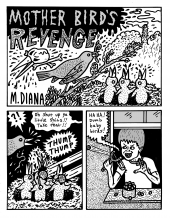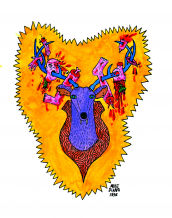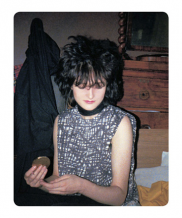| Umělec magazine 2003/2 >> Tereza Janečková is an artist | List of all editions. | ||||||||||||
|
|||||||||||||
Tereza Janečková is an artistUmělec magazine 2003/201.02.2003 Zuzana Štefková | news | en cs |
|||||||||||||
|
Tereza Janečková is a student at the Academy of Fine Arts in Prague, the Czech Republic, yet she was able to advantageously commercialize and publicize her latest artistic project. In the pages of the Czech magazine Reflex, in an article entitled “Heart and Spades,” J. X. Doležal mulled over what it was that brought this student to realize one project: a pornographic photo-series printed in the pages of Hustler magazine. A desire for sensation? Or maybe the inability to come up with something more sensible? His conclusion was as follows: “Art only needs to show itself, to make some rumpus around itself and attract attention.” Apart from this, he also noted that a) the photography was not radical enough, because there are magazines on sale with ugly and fat girls in them; b) the story, too, fails to show anything revolutionary, so the only thing which is new and worthy of attention is the fact that no student from AVU has yet taken such photos for Hustler.
Jiří David’s review, which was attached to the article, was more enlightening. Unlike Doležal, he took into account the art-historical and social context of the work and the “unsuitable place” of its presentation, and not only Tereza’s proportions. David wrote that when the artist works with old concepts (“world art carried out the boom of the body quite intensively a long time ago”) “the connection with Hustler changes its meaning.” Lenka Lindaurová in Mladé Svět commented that the whole performance was a loose, superficial parody. According to her, Tereza Janečková is carrying “wood to the forest” and her work comes across as “close to” seriously “intended photography as a less successful variation on the same.” I mention the above opinions here because the final work of Tereza Janečková can only be placed in these kinds of quotations. In the artist’s own words: “the aim of my project is to create a picture whose creator is not, however, the artist alone, but also a group … the authors’ acquaintances from the contemporary media.” The result is like Hustler’s front cover displaying the artist’s photography, and where, instead of titles like: “Mama, the Teacher’s Bliss” and “The Lechers of Czech Pop Music” there are quotations taken from different articles on the theme “Stripped Down Artist,” which appeared in the press. What, then, is the real aim of the work that the artist deliberately kept secret from the original reviewers? Tereza Janečková was not interested in scandal or, in the end, pornography. Both phases (photography in Hustler and the “collective work” monitoring the reception of the photos) have one common theme: an interest in the mechanistic constitution of pictures of a woman (and) artist in the context of a pornographic magazine and similar media. The collage made up of reactions to the incriminating photography reflects the way that “artists are reproduced” from texts written by professional journalists and critics. The game of the structure of figuration and the perception of pictures in a certain context happen at both a physical level and on the plane of the construction of personality. In the artist’s opinion, the result of her project “the girl from the poster” is thus a completely new media identity. If the whole experience is not to be simply pigeonholed, as J.X. Doležal does, as the desire for self-inflicted scandal and a chance for some easy money, and if we are going to take seriously the artist’s intention to explore the image of women in society and the construction of the artist’s identity, then finding good reasons for making this type of work is not difficult. First: the visual mechanisms that help create images of women as sources of pleasure and as goods like any other (i.e. ads) are nearly invisible in our environment. And a critical view of things is uncommon, even among those who do not plough fields. J. X. Doležal himself substantiated this best when he refused to consider the relevance of the artist’s text, with which his article is interlaced. It is then possible to say that a certain form of visual discourse is still contemporary here, even if it seems somewhat passé in the context of Anglo-American art. If this method of artistic production is be to taken exclusively as a non-inventive attempt at self-advertising, then apparently there’s a need for it. The reaction of Doležal is, from this point of view, comparatively radical, as it reveals a blind spot that exists in our society, and, to a certain extent, is also at large in the world of art history. Second: Tereza Janečkov’s concept is not an independent feminist project. Rather, it deals with wider questions formed by pictures in the media which do not have to be bound to a tribe of media personalities. This shows up — evidently quite unintentionally — in the way the creation of a media identity contributes to the dissolution of the “real subject.” “Who is Tereza Janečková?” is a weaker question than “what can she be in these circumstances?” Photography in Hustler initiated for the artist a new “I” which is defined from outside and whose appearance changes together with the mounting reactions, as if we were witnesses to the growth of a new kind of creature. At the same time, the artist is satisfied with the fact that the use of her own body gave the initial impulse to the process and subsequently set in motion its own media campaign. Her resultant picture touches on the problems of authorship, and the construction of the author, and on so-called celebrity, which are media figures or virtual souls, whether he or she is an already fixed star in the sky or an anonymous woman (or man), who (about whom) some juicy scandal brings to ephemeral fame and bold type in the pages of newspapers.
01.02.2003
Recommended articles
|
|||||||||||||
|
04.02.2020 10:17
Letošní 50. ročník Art Basel přilákal celkem 93 000 návštěvníků a sběratelů z 80 zemí světa. 290 prémiových galerií představilo umělecká díla od počátku 20. století až po současnost. Hlavní sektor přehlídky, tradičně v prvním patře výstavního prostoru, představil 232 předních galerií z celého světa nabízející umění nejvyšší kvality. Veletrh ukázal vzestupný trend prodeje prostřednictvím galerií jak soukromým sbírkám, tak i institucím. Kromě hlavního veletrhu stály za návštěvu i ty přidružené: Volta, Liste a Photo Basel, k tomu doprovodné programy a výstavy v místních institucích, které kvalitou daleko přesahují hranice města tj. Kunsthalle Basel, Kunstmuseum, Tinguely muzeum nebo Fondation Beyeler.
|






























 New book by I.M.Jirous in English at our online bookshop.
New book by I.M.Jirous in English at our online bookshop.
Comments
There are currently no comments.Add new comment